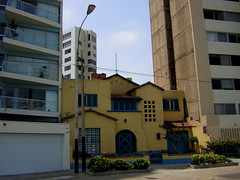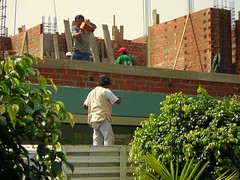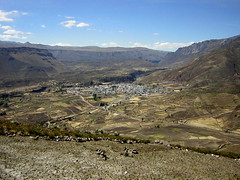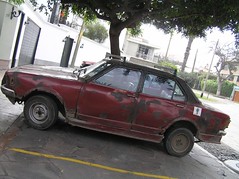Destruction of Lima’s architectural heritage [Featured]
Lima grows ever higher. In districts like Miraflores, Chorrillos, Barranco and San Isidro are loosing more and more of of their traditional homes, the majority of which built in the early 1900s. They are forced to make way for grand towers and modern apartments that ignore the style of the surrounding area and simply don’t fit. Worse still many defy urban-planning rules implemented by local municipalities.
by María Laura Hernández de Aguero
(Readers of this article might also enjoy reading about a similar problem in central Lima)
It’s been 25 years since I moved to a quiet street in Barranco. I had found what I was always looking for – a house from the end of the 19th century with high ceilings, internal corridors and a patio with wooden balustrades. The prettiest part was the little square, almost abandoned, in front of the house with a sea-view beyond.
After a while the little ranch next door that was surrounded by an enormous garden was sold, and architect Mario Lara constructed a beautiful building that fitted in well with the surroundings. In a festive atmosphere, the neighbours repaired the little square with old-style paving stones and planted new trees and bushes. We had a little inauguration ceremony when all was completed – our little street was a paradise. The neighbourhood kids played in the street where barely a car passed and there was a friendly feeling to the place.
As the years passed, progress arrived, obliterating various little old houses and erecting huge modern buildings. Luckily, my romantic home was sold to a young stock broker who fell in love with the ample space and the sea view, but my little street stopped being a peaceful retreat. An arrogant constructor destroyed a part of out little square, seizing a good stretch of it to have access to a modern and pretentious block of apartments that stood which blocked the sea view, authorised by a mayor that ignored the historical nature of the area in handing out construction licences that will affect the look and feel of Barranco forever.
Lima is growing franticly and the oldest residential areas are disappearing before the great push of speculators and investors. Houses, ranches and quintas and destroyed before a modernity that ignores the potential there could have been in conservation. The investors arrive, construct, sell and leave – more interested in producing capital that the quality of life of the residents. In Magdalena, Miraflores, Chorrillos and Barranco, no plan exists in regards to urban planning and apartment blocks rise that preserve little of the neighbourhood’s atmosphere and architectural style. Conservation of historic buildings is, for the majority of mayors and municipalities, a quite uncomfortable subject. Is the money to blame?
 In Miraflores, that was one of the those enchanting neighbourhoods in Lima, the houses and old ranches are squeezed and suffocated between huge towers that don’t even let daylight through and destroy all privacy. The investors want to construct so high, higher than the local church towers, higher than everything in the civic centre, even though public services will end up collapsing within a short time. Streets are converted into makeshift parking lots, cars creeping on the to walkways, onto the grassy shoulders and crushing up against trees, trying to find any space possible to park, while the signs on the apartments for sale announce their luxury and comfort.
In Miraflores, that was one of the those enchanting neighbourhoods in Lima, the houses and old ranches are squeezed and suffocated between huge towers that don’t even let daylight through and destroy all privacy. The investors want to construct so high, higher than the local church towers, higher than everything in the civic centre, even though public services will end up collapsing within a short time. Streets are converted into makeshift parking lots, cars creeping on the to walkways, onto the grassy shoulders and crushing up against trees, trying to find any space possible to park, while the signs on the apartments for sale announce their luxury and comfort.
“In Miraflores, like in almost all of Lima, there is an architecture of very low quality. There are no regulations for conserving the local style, and everyone only thinks in the short term”, says David Mutal, an architect working on remodelling an only chalet in Miraflores without altering its lines and conserving its historic beauty. “This was a typical ranch of the 1920s that we are converting into loft-style apartments. We are saving the general form of the house, conserving the two patios and creating a strong contrast between traditional and modern”.
Carlos Estrada Guzmán has lived for more than 40 years en the 6th block of Bolognesi Avenue, in one of the old houses that were fashionable in Lima during the 1950s. “It was a quiet pleasant neighbourhood to live in, and here you lived well. But now Tripoli street, the street that abuts this one, well, everything has been destroyed. It’s OK that they built low-rise buildings, but look at how appalling they look. The mayors don’t protect the houses, but they allow those horrible casinos to be built. This is an affront to our culture and our traditions, don’t you think?”.
In the main avenues they continue building more new apartment blocks that destroy the view and the local atmosphere, and the residents don’t stop protesting. Thankfully, there are still some houses that are conserved that represent the architecture of some interesting era or another. In the Oliviar there are an interesting variety of European-style chalets that were built and the end of the 1930s, and in the Pezet area there are still some jewels from the beginning of modern architecture in Lima, houses and buildings built between the 50s and 60s in the style of Bauhaus, a movement that began in Germany at the start of the 20th century.
Luckily, all is not lost. There are today a group of young investors that are starting to value the conservation and know that it is what foreign visitors are interested in seeing. Some old houses in San Isidro, Barranco and Miraflores have been bought by them and remodelled into apartments to rent, restaurants and small hotels, following the pattern in major cities throughout the world who better value their architectural heritage.
(Readers of this article might also enjoy reading about a similar problem in central Lima)
Tags: 1900s, architecture, barranco, chorrillos, historic buildings, miraflores, [Featured]










